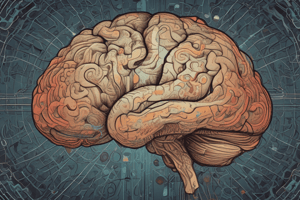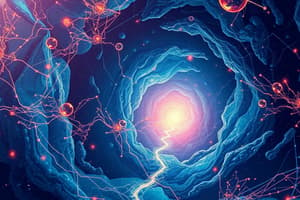Podcast
Questions and Answers
What is a distal stimulus, proximal stimulus, and percept image?
What is a distal stimulus, proximal stimulus, and percept image?
Distal stimulus is the object, proximal stimulus is the inverted image reflected onto the cornea, the percept image is what you see after the brain flips the image.
Describe the structure of a neuron.
Describe the structure of a neuron.
Nucleus- location of the DNA; Dendrite- receives cell signals at synapses; Soma- cell body that contains the nucleus and other structures; Axon- carries info away from soma; Axon Hillock- site of summation; Terminal buttons- release neurotransmitters.
Diagram and describe the seven parts of the eye.
Diagram and describe the seven parts of the eye.
Pupil- light enters through; Lens- focuses the light; Cornea- focuses the light; Optic nerve- transmits image to the brain; Fovea- focus point of the eye; Iris- adjusts the pupil; Retina- layers that trigger impulses.
What is the electromagnetic spectrum, and what parts are we sensitive to?
What is the electromagnetic spectrum, and what parts are we sensitive to?
What is the blind spot and what do we normally see in it?
What is the blind spot and what do we normally see in it?
What are rods and cones, and what are their differences?
What are rods and cones, and what are their differences?
What is the distribution of rods and cones across the retina?
What is the distribution of rods and cones across the retina?
What is the importance of change at the receptor level?
What is the importance of change at the receptor level?
What is a stabilized retinal image and how is it produced?
What is a stabilized retinal image and how is it produced?
What are examples of stabilized like effects from other senses?
What are examples of stabilized like effects from other senses?
What are temporal and spatial edges, and how can they be sharp or gradual?
What are temporal and spatial edges, and how can they be sharp or gradual?
Describe Hubel and Wiesel's feature detection theory and a criticism of it.
Describe Hubel and Wiesel's feature detection theory and a criticism of it.
Describe a split-brain study and its implications on visual pathways.
Describe a split-brain study and its implications on visual pathways.
Diagram the visual pathways from the retina to the visual cortex.
Diagram the visual pathways from the retina to the visual cortex.
Describe the LGN and its layers.
Describe the LGN and its layers.
What did Schiller do and what did he find?
What did Schiller do and what did he find?
Describe the Gauthier et al. 'greebles study' and the fusiform face area.
Describe the Gauthier et al. 'greebles study' and the fusiform face area.
What are four examples of the Gestalt principles of organization?
What are four examples of the Gestalt principles of organization?
What is figure-ground segregation and its governing rules?
What is figure-ground segregation and its governing rules?
What is shape from shading and its significance?
What is shape from shading and its significance?
What is size constancy?
What is size constancy?
Describe oculomotor, monocular, movement produced, and binocular cues with examples.
Describe oculomotor, monocular, movement produced, and binocular cues with examples.
What is the relationship between size and distance?
What is the relationship between size and distance?
Describe the Holway and Boring (1941) study on size perception.
Describe the Holway and Boring (1941) study on size perception.
What is the moon illusion and what are the theories behind it?
What is the moon illusion and what are the theories behind it?
Flashcards
Distal Stimulus
Distal Stimulus
The actual object in the environment that you are looking at.
Proximal Stimulus
Proximal Stimulus
The inverted image of the object formed on the retina of your eye.
Percept
Percept
The final processed visual representation created by your brain.
Neuron Nucleus
Neuron Nucleus
Signup and view all the flashcards
Dendrites
Dendrites
Signup and view all the flashcards
Soma
Soma
Signup and view all the flashcards
Axon
Axon
Signup and view all the flashcards
Axon Hillock
Axon Hillock
Signup and view all the flashcards
Terminal Buttons
Terminal Buttons
Signup and view all the flashcards
Pupil
Pupil
Signup and view all the flashcards
Lens
Lens
Signup and view all the flashcards
Cornea
Cornea
Signup and view all the flashcards
Optic Nerve
Optic Nerve
Signup and view all the flashcards
Fovea
Fovea
Signup and view all the flashcards
Iris
Iris
Signup and view all the flashcards
Retina
Retina
Signup and view all the flashcards
Electromagnetic Spectrum
Electromagnetic Spectrum
Signup and view all the flashcards
Blind Spot
Blind Spot
Signup and view all the flashcards
Rods
Rods
Signup and view all the flashcards
Cones
Cones
Signup and view all the flashcards
Rod and Cone Distribution
Rod and Cone Distribution
Signup and view all the flashcards
Change at the Receptor Level
Change at the Receptor Level
Signup and view all the flashcards
Stabilized Retinal Image (SRI)
Stabilized Retinal Image (SRI)
Signup and view all the flashcards
Sensory Adaptation
Sensory Adaptation
Signup and view all the flashcards
Temporal Edges
Temporal Edges
Signup and view all the flashcards
Spatial Edges
Spatial Edges
Signup and view all the flashcards
Study Notes
Distal and Proximal Stimuli
- Distal stimulus refers to the actual object in the environment.
- Proximal stimulus is the inverted image formed on the retina.
- The percept image is the final processed visual representation created by the brain.
Neuron Structure
- Nucleus: contains DNA and genetic information.
- Dendrites: receive signals from other neurons at synapses.
- Soma: cell body housing the nucleus and other organelles.
- Axon: a single fiber that transmits information from the soma to synaptic terminals.
- Axon Hillock: junction where input signals are integrated.
- Terminal buttons: release neurotransmitters to communicate with other neurons.
Components of the Eye
- Pupil: opening allowing light to enter.
- Lens: focuses light onto the retina.
- Cornea: primary structure for focusing light.
- Optic nerve: transmits visual information from the retina to the brain.
- Fovea: area of the retina with the highest density of cones and visual acuity.
- Iris: regulates the size of the pupil based on light levels.
- Retina: layers at the back of the eye that initiate visual signal processing.
Electromagnetic Spectrum
- The spectrum ranges from gamma rays to radio waves.
- Human sensitivity is greatest to red, green, and blue light due to cone receptor tuning within a narrow spectrum range.
Blind Spot
- The blind spot occurs where the optic nerve exits the retina, lacking photoreceptors.
- The brain compensates for this gap by filling in surrounding details.
Rods vs. Cones
- Rods are responsible for low-light (scotopic) vision.
- Cones function in bright light (photopic) vision and color perception, differing structurally (triangular vs rectangular).
Rods and Cones Distribution
- Distribution across the retina varies, with cones concentrated in the fovea and rods located predominantly in peripheral regions.
Change at the Receptor Level
- Perception requires change; without it, visual stimuli are undetectable.
- Microtremors contribute to this necessary sensory change.
Stabilized Retinal Image (SRI)
- SRI refers to images that remain stationary on the retina, leading to diminished perception.
- Various conditions, like paralysis or constant light, can create such images.
Adaptation to Unchanging Stimuli
- Sensory adaptation occurs when constant stimulation leads to decreased sensitivity over time (e.g., becoming "nose blind").
Temporal and Spatial Edges
- Temporal edges refer to changes in stimuli over time (e.g., gradual volume increase).
- Spatial edges involve abrupt shifts in stimuli (e.g., entering a dark room).
Hubel and Wiesel's Feature Detection Theory
- Proposes specific neurons respond to distinct visual stimuli.
- Criticized as unrealistic due to the infinite variety of potential stimuli and corresponding neuron limitations.
Split Brain Studies
- Involve severing the corpus callosum, affecting communication between brain hemispheres.
- Demonstrated differing functions, revealing that language control resides in the left hemisphere.
Visual Pathways
- Visual information travels from the retina through the optic nerve to various brain regions, including the lateral geniculate nucleus (LGN) and visual cortex.
Lateral Geniculate Nucleus (LGN)
- Has ipsilateral layers receiving signals from the same side eye (layers 2, 3, 5).
- Contralateral layers receive input from the opposite eye (layers 1, 4, 6).
- Contains parvocellular layers for color and texture processing and magnocellular layers for motion detection.
Gauthier et al. "Greebles Study"
- Investigated the fusiform face area (FFA) response to faces versus novel objects (greebles).
- Findings suggest FFA activation is experience-dependent, enhancing response to familiar stimuli.
Gestalt Principles of Organization
- Closure: tendency to perceive incomplete shapes as whole.
- Proximity: objects close together are perceived as related.
- Figure and Ground: distinguishing foreground objects from the background.
- Order and Symmetry: symmetrical elements are grouped and seen as unified.
Figure-Ground Segregation
- Visual process categorizing elements into figure or background (e.g., dual images like faces vs. vase).
- Influences memory recall based on perceptual focus.
Shape from Shading
- Refers to visual interpretation of an object's form based on light and shadow.
- The visual system relies on shading to discern object characteristics.
Size Constancy
- Size perception remains stable regardless of changes in the retinal image size.
- Recognizes that objects perceived similarly based on distance and context retain their actual size.
Depth Cues
- Oculomotor cues: rely on eye movement and lens shape adjustment (convergence and accommodation).
- Monocular cues: depth perception from one eye, using pictorial cues (e.g., occlusion).
- Movement-produced cues: changes in position give depth information (motion parallax).
- Binocular cues: use the disparity between images from both eyes to determine distance.
Size and Distance Relationship
- Objects appear smaller as they increase in distance, while closer objects appear larger.
Holway and Boring Study (1941)
- Examined how visual angle affects size perception using varying distance and comparison circles.
- Findings showed size estimation relies heavily on depth cues and visual angle rather than physical size.
Moon Illusion
- The phenomenon occurs due to perceived distance affecting the perceived size of the moon in relation to the horizon.
- Boring's explanation linked visual angle discrepancies to perceived size differences.
Studying That Suits You
Use AI to generate personalized quizzes and flashcards to suit your learning preferences.




